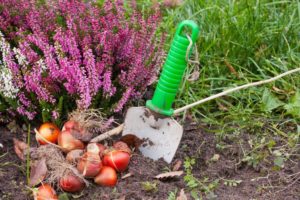How to Use Bulbs to Plant a Beautiful Spring Flower Garden
 There are many ways to plant bulbs — formal gardens, scattered in lawns, under trees, or strategically planted throughout beds and borders. Therefore, careful planning will yield the best results. Many bulbs will naturalize in an area and multiply, coming back year after year, so plan carefully and you can have years of enjoyment from one planting.
There are many ways to plant bulbs — formal gardens, scattered in lawns, under trees, or strategically planted throughout beds and borders. Therefore, careful planning will yield the best results. Many bulbs will naturalize in an area and multiply, coming back year after year, so plan carefully and you can have years of enjoyment from one planting.
- Plant in clusters for greater visual impact.
- Take into account bloom time — plant a combination of early, mid- and late-season bloomers to extend the season.
- Hide dying foliage of low-growing bulbs that are past their prime with taller bulbs planted in front.
- Layer plant heights from front to back when planting varieties that will bloom at the same time.
- Many bulbs are perfect for container planting — bring them into view when blooming and move out of the way when foliage is wilting and when dormant. Plant closer together in containers than specified for in-ground planting.
- Bulbs can provide bright, vibrant color — think about how those colors will blend with their surroundings.
- Clever bulb planting starts at the garden center with high-quality bulbs. Look for bulbs that are plump and firm. It’s typically best to avoid any that are soft and mushy or have mold growing on them. Also, look for big bulbs; the bigger they are, the more they generally bloom compared to smaller bulbs of the same
- There are 2 types of bulbs. Spring bulbs:Also called hardy bulbs, these bulbs are planted in fall, spend winter in the ground, and flower in spring and Summer bulbs: Also called tender bulbs, these bulbs are planted in spring and flower or leaf out in summer. Summer bulbs aren’t tolerant of cold temperatures and should only be planted after the ground warms up and there’s no longer a threat of frost. If purchased before planting time, store them in a cool, dry spot until planting.
- As long as you ensure that your bulbs have good drainage and sunlight, you can plant them just about anywhere. Drainage is critical to keep bulbs from rotting. They like loamy or slightly sandy soil because it provides the drainage and nutrients they need.
- Early-spring bloomers can be planted under deciduous trees where they’ll get enough sun to bloom before the tree’s leaves block out the light. However, they’ll only bloom well the first year, as they’ll need sunlight later in the season for the leaves to gather enough energy for next year’s flowers.
- Determine the planting depth for the type of bulb you’re planting. If planted too deep, flowers will bloom late or not at all. If planted too shallow, new growth may become exposed too soon and risk damage by cold temperatures. If you are unsure of the exact planting depth, a good general rule of thumb is to plant the bulb 2 to 3 times as deep as the bulb is tall. There are lots of ways to make the hole to plant a bulb. One of the best ways is to use a hand drill powered auger and one of the best is Tech Team’s #777 https://techteamproducts.com/product/3-x-9-bulb-and-seedling-planter-auger-fits-3-8-drill-00777/ https://www.amazon.com/dp/B07S385BW7?ref=myi_title_dp and #778 https://techteamproducts.com/product/3-x-24-bulb-and-seedling-planter-auger-fits-3-8-drill-00778/ https://www.amazon.com/dp/B07S386MWG?ref=myi_title_dp . The #777 is 9” long while the #778 is 24” so that you can make your holes while standing up. You can do a hey Alexa or hey Siri Google search to explore other options or you can watch this you tube video ttps://youtu.be/SZG_rADSPf8
- Prepare the soil by loosening and mixing in organic material if needed for added nutrients or to improve drainage.
- Place the bulbs with the pointy-end up and with the roots down. If you’re not sure of the top or bottom of the bulb, plant it on its side and it will find its way to the surface.
- Cover with soil and a light layer of mulch.
- Newly planted bulbs should be watered well to get settled in.
- Now sit back and wait for your beautiful garden
